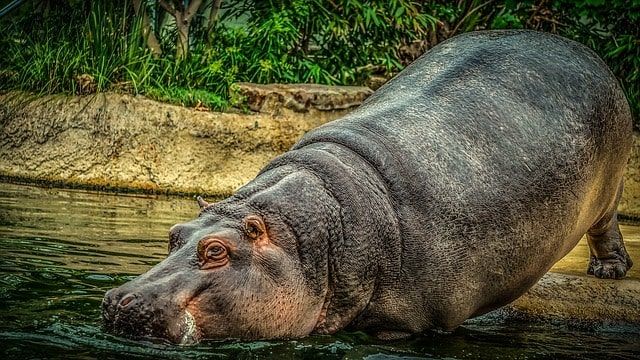There will be 1,500 by 2035: How Pablo Escobar brought hippopotamuses to Colombia
Pablo Escobar's hippos have found a suitable home between Medellín and Bogotá. At dusk, they have ample grazing areas. See more information about the hippopotamuses.

Pablo Escobar's hippos find a favorable habitat between Medellín and Bogotá. At night they have large areas to graze. Unlike in Africa, they do not have to contend with natural predators in Colombia. In the middle of the mountain range, what was once Pablo Escobar's hacienda was home to kangaroos, giraffes, elephants, and other exotic species, a veritable zoo of illegally imported animals that was the ultimate ostentation during his reign as a cocaine trafficking kingpin.
Escobar and his Medellin Cartel are no longer around, but one of the species he brought with him is reproduced in and around the hacienda, which has been converted into a theme park: the hippopotamus. Like the man who brought them after buying them from a zoo in the United States, the animals are a source of controversy.
Government efforts to control their reproduction have not worked and the number of hippos has risen from 35 to between 65 and 80 in the last eight years. A group of scientists warns that the hippos compromise the area's biodiversity and could kill local people. If nothing is done, by 2035 there could be 1,500 hippos in this region of Colombia.
Many experts say they should be exterminated. The idea of executing the animals has received some criticism and it is foreseeable that more will arrive. There was a lot of commotion when three hippos escaped from Escobar's ranch and caused trouble. One of them was killed by a hunter.
The residents of this rural area have grown fond of the hippos, partly because they attract tourists and their dollars. That affection surprises many outsiders, given the dangerous nature of the animals, which in Africa cause more deaths than any other wild animal. Children here are accustomed to walking past a sign that reads "Danger - Presence of Hippos" on their way to school.
Experts say that government efforts to control animal reproduction through sterilizations are not enough. Scientists began focusing on the animals' reproduction last year after one of the animals chased and seriously injured a farmer. Their study was published in the journal Biological Conservation in January.
Another study last year by researchers at the University of California, San Diego, found that hippos are altering the quality of the water in which they spend much of their time and defecate. As their population increases, they may end up displacing native animals such as the West Indian manatee.
In the 1980s Escobar brought three females and one male to his 2,225-hectare Hacienda Nápoles. After his death in a shootout with authorities in 1993, most of the exotic animals were relocated or died. But the hippos were abandoned because of the cost and logistical problems of transporting three-ton animals through an area where violence reigned.
The hippos find a favorable habitat between Medellín and Bogotá. They live around the Magdalena River and spend most of their time in lakes and other water sources. At night they have large areas for grazing. Unlike in Africa, they do not have to deal with natural predators in Colombia.
The best solution would be to put the animals down, but their magnetic personality and existing regulations do not allow it. The government banned the hunting of hippos after the uproar caused by the killing of one and the dissemination of a photo of soldiers posing with the dead animal, as if it were a hunting trophy.
It was decided to sterilize them, but this is a complex and costly process. First, a way must be found to get the animal into a huge metal pen to be sedated. Then a team of experts must spend three hours making incisions in the thick skin of the animals and try to find the reproductive organs, which is not easy.
Each sterilization costs the equivalent of about $8,500, a very high sum for the government agency in charge of the animals. He indicated that the producers of a documentary financed an intervention in 2019 and that another production will do the same this year. There were no sterilizations in 2020 due to the coronavirus pandemic.
The agency has performed 10 sterilizations and relocated four young hippos, which were sent to zoos in Colombia. Zoos in other countries have expressed interest in the animals, but bureaucratic hurdles are an obstacle. This year the agency expects to test another type of sterilization with chemical substances that worked on pigs.




